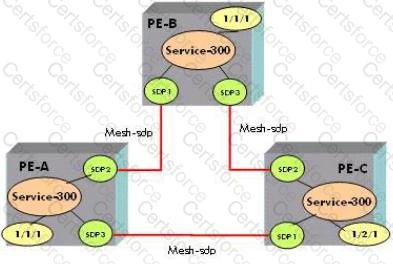Click on the exhibit below.

CE-A is on VLAN 200 and CE-B is on VLAN 300. Which of the following SAP ids can be configured on PE-A and PE-B to allow direct communication between CE-A and CE-B?
Click on the exhibit below.

CE-A sends frames with 2 tags. If the SAP on PE-A is "sap 1/1/1:1 .*" and the SAP on PE-B is "sap 1/1/1:100.200" how many tags will there be on the frame when it egresses from the SAP on PE-B?
An l-VPLS is configured with a service id of 511. What will the value of the l-SID be assuming a default configuration?
Which of the following are required for an operational mesh-sdp binding for bidirectional traffic when signaling is enabled within the SDP? (Choose 3)
Which failure scenario is NOT supported by IEEE 802.lag?
Click on the exhibit below.

A new router named PE-D is to be directly connected to PE-C and is required to be added to the existing VPLS 300. The design requires the least amount of signaling, the least amount of configuration changes for existing sites and the new site has to have access to all existing sites. How should the new site be added to VPLS 300?
Which of the following needs to be considered when designing Ethernet networks with redundancy?
In RSTP, how is the root bridge selected?
What function in IEEE 802.1 ah helps to limit the amount of MAC addresses learned in the core?
Which of the following are true when ports are configured with the IEEE 802.3ah Loopback Control feature? (Choose 3)